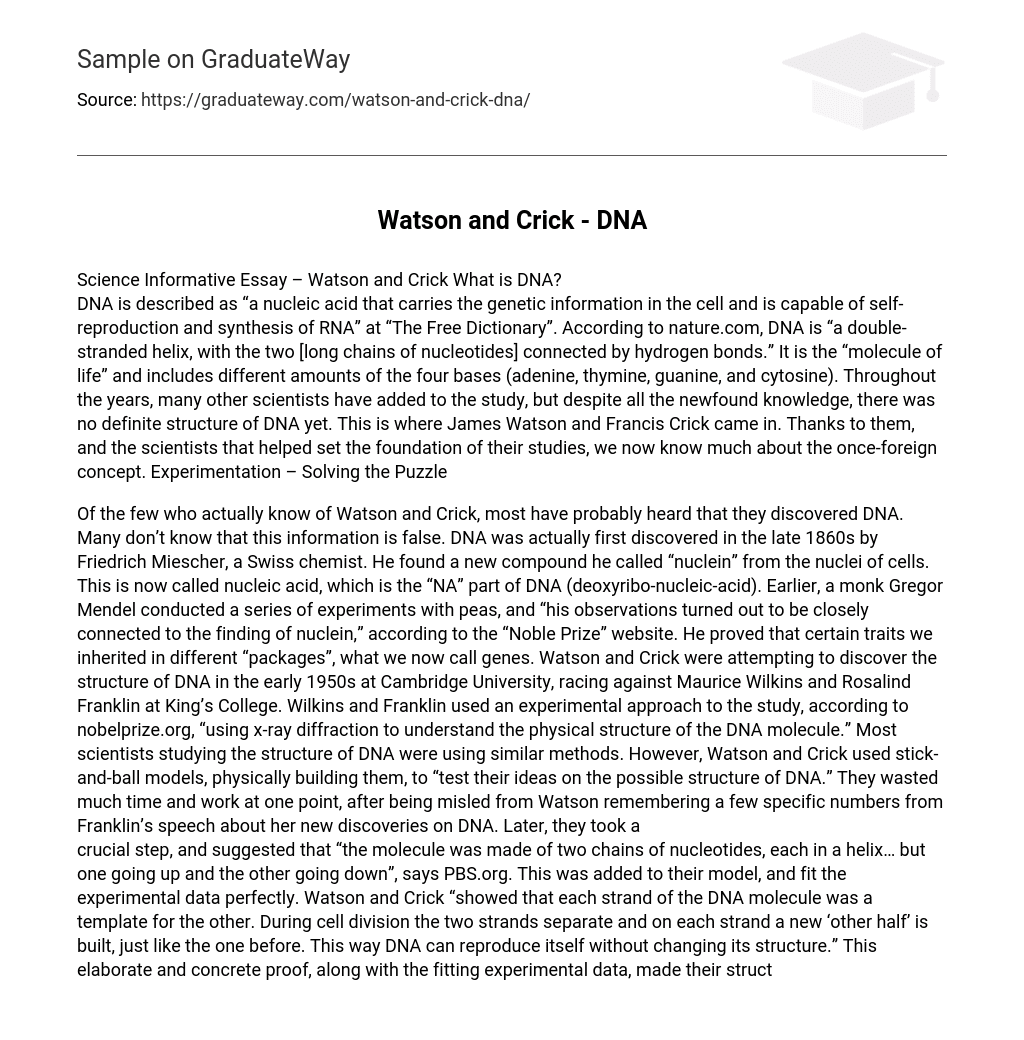Science Informative Essay – Watson and Crick What is DNA?
DNA is described as “a nucleic acid that carries the genetic information in the cell and is capable of self-reproduction and synthesis of RNA” at “The Free Dictionary”. According to nature.com, DNA is “a double-stranded helix, with the two [long chains of nucleotides] connected by hydrogen bonds.” It is the “molecule of life” and includes different amounts of the four bases (adenine, thymine, guanine, and cytosine). Throughout the years, many other scientists have added to the study, but despite all the newfound knowledge, there was no definite structure of DNA yet. This is where James Watson and Francis Crick came in. Thanks to them, and the scientists that helped set the foundation of their studies, we now know much about the once-foreign concept. Experimentation – Solving the Puzzle
Of the few who actually know of Watson and Crick, most have probably heard that they discovered DNA. Many don’t know that this information is false. DNA was actually first discovered in the late 1860s by Friedrich Miescher, a Swiss chemist. He found a new compound he called “nuclein” from the nuclei of cells. This is now called nucleic acid, which is the “NA” part of DNA (deoxyribo-nucleic-acid). Earlier, a monk Gregor Mendel conducted a series of experiments with peas, and “his observations turned out to be closely connected to the finding of nuclein,” according to the “Noble Prize” website. He proved that certain traits we inherited in different “packages”, what we now call genes. Watson and Crick were attempting to discover the structure of DNA in the early 1950s at Cambridge University, racing against Maurice Wilkins and Rosalind Franklin at King’s College. Wilkins and Franklin used an experimental approach to the study, according to nobelprize.org, “using x-ray diffraction to understand the physical structure of the DNA molecule.” Most scientists studying the structure of DNA were using similar methods. However, Watson and Crick used stick-and-ball models, physically building them, to “test their ideas on the possible structure of DNA.” They wasted much time and work at one point, after being misled from Watson remembering a few specific numbers from Franklin’s speech about her new discoveries on DNA. Later, they took a
crucial step, and suggested that “the molecule was made of two chains of nucleotides, each in a helix… but one going up and the other going down”, says PBS.org. This was added to their model, and fit the experimental data perfectly. Watson and Crick “showed that each strand of the DNA molecule was a template for the other. During cell division the two strands separate and on each strand a new ‘other half’ is built, just like the one before. This way DNA can reproduce itself without changing its structure.” This elaborate and concrete proof, along with the fitting experimental data, made their structure almost immediately accepted in the science world. What Happened After?
Though many scientists have studied Watson and Crick’s discovery, few changes and improvements have been made. There have only been elaborations and additional information, for there are three different conformations of DNA, while their structure only proposed the most common. Perhaps Watson and Crick did not discover DNA, but they were the first to formulate an accurate description of the molecule’s complex, double helical structure. Their discovery paved the way for more scientists to add to the study of DNA. In 1962, they jointly received the Nobel Prize in physiology or medicine, along with Maurice Wilkins. Sadly, by that time Franklin had already passed away from cancer, but many citizens thought it unfair for her not to be honored. Many said believed Watson and Crick didn’t deserve it, that Franklin was the one who truly brought them to the position of their discovery. Nevertheless, they didn’t dispute over their Nobel Prize. DNA was known as the discovery of the century, and thanks to the numerous scientists, we now have a great understanding of biology. Who knows what is next to come?
Bibliography
” The Discovery of the Molecular Structure of DNA – The Double Helix.” The Discovery of the Molecular Structure of DNA. Nobel Media AB, 2013. Web. 09 Oct. 2013.
“DNA – Definition of Evolution By the Free Online Dictionary.” Thefreedictionary.com. N.p., n.d. Web. 9 Sept. 2013.
“James Watson, Francis Crick, Maurice Wilkins, and Rosalind Franklin.” Homepage of the Chemical Heritage Foundation. N.p., n.d. Web. 09
Oct. 2013.
Maule, David, and James D. Watson. The Double Helix. Harlow, England: PearsonEducation, 2008. Print.
Pray, Leslie A. “Discovery of DNA Structure and Function: Watson and Crick.”Nature.com. Nature Publishing Group, n.d. Web. 09 Oct. 2013.
“Watson and Crick.” BBC News. BBC, n.d. Web. 09 Oct. 2013.
“Watson and Crick Describe Structure of DNA.” PBS. PBS, n.d. Web. 09 Oct. 2013





